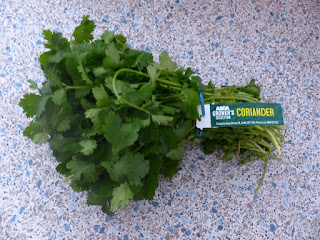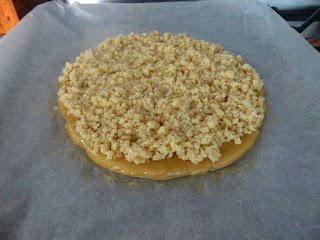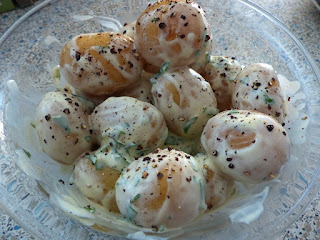The recipes: no. 12, "Tomato & Okra Curry"; p203, "Rice Pilaf with Almonds & Sultanas"
Typing the words "Lockdown Edition" for the twelfth time got me to thinking. A friend recently said he felt lockdown was essentially over now that he'd booked a hair appointment for a few weeks' time. And I totally get that sentiment. With the beaches overcrowded and people being encouraged to visit everywhere from the pub to Primark, it's hard to act like we're in full-on crisis mode even as the virus persists. But for me, as long as there's still no parkrun, no organised running generally, no theatre, no concerts, no stress-free foreign travel - all the things that make life more than just a slog in service of capitalism, in other words - as long as that's the case, "lockdown" as I choose to define it continues, and so does this silly little blog.
And it continues with a double feature, no less. Because the random wheel of fortune landed on a curry recipe from one of the folders of "stuff I've downloaded from the internet/been recommended by friends", I spontaneously decided to also randomise the side dish by picking a page from within the "Rice & Other Grains" section of Madhur Jaffrey's Curry Easy. That could have seen me making my own chapatis or parathas from scratch - fun! - but instead it's a fairly straightforward rice side to accompany a tomato and okra curry that was originally sent my way by a friend from a football forum, of all things.
What this means is Week 12 is not just vegetarian-friendly but, if you remove the little bit of butter the recipe calls for (and I tend to prefer to do that anyway), vegan-friendly too. Makes a nice change after all that duck, chicken and fish. And while the rice recipe remains under Madhur-shaped copyright, the curry comes from off of the internet so you can even read along at home if you want to - though I did have to use archive.org to retrieve the original page. It was actually quite nice to read it again after so long, since I only printed out the recipe part at the time, and not the accompanying blog post (so much for blogger solidarity). Although I note the latter section does contain the line "I think rice tends to make vegetable curries boring". Oh. Well, moving on...
The prep: The recipe calls for six tomatoes, and this week's Riverford veg box has kindly given me exactly that to work with.
The almonds and sultanas I need for Madhur's rice pilaf are still in plentiful supply following my adventures in aubergine a few weeks ago, and while the okra for the curry does require a trip to one of the Sri Lankan shops on Loampit Hill whose two-metre distancing policy is basically the owner shouting at you if you come in when you shouldn't, that's a good excuse to stock up on gloriously unhealthy snacks while I'm there.
With most of the other ingredients being store cupboard staples for any curry-friendly household, all that remains is for me to judge exactly what constitutes a "good handful" of coriander. People have different-sized hands, after all.
The making: Being from a blog rather than a recipe book, the somewhat casual nature of the ingredients list for the curry is also reflected in the method. It's almost like having to recreate a dish based on a Random Kitchen post. Which could be a blog in itself, if anyone else is bored on lockdown...
I start by halving a large onion and chopping one half into crescents and the other into "rough chunks".
The crescents of onion go into a big saucepan and are softened in a little oil. While that happens, it's time to make a curry paste (of sorts). This I do by putting the chunks of onion in a blender along with some garlic, bird's eye chillies, ginger, and the stalks from my "handful" of coriander. This all gets whizzed up before a glug of olive oil is added along with some ground coriander, cumin and turmeric. While it's hardly a classy method, it can't be faulted for speed and very soon I have a paste of sorts, albeit one that is looking rather coriander-heavy.
 |
| It's not easy being green |
Maybe my hands are on the big side, I don't know. Anyway, coriander is awesome, so I see no real issue here.
This paste is added to the softened onions, as are some cardamom pods, and the spices are "cooked out". I sort of know what that means without actually knowing. Basically I'm looking for them to release their fragrance. Which they duly do over the next five minutes or so - though (as the recipe suggests) I add some extra oil, as otherwise the fragrance would be less "aromatic spice paste" and more "burnt stuff".
At this point, I add a tin of tomatoes - the recipe just says "plum tomatoes", but context suggests to me that they should be chopped - plus 400ml of water. This is brought to the boil, sea salt is added, then it's time for me to carefully add the fresh tomatoes. These go in whole, and that's how they'll stay. I find this a really interesting idea, even if it does look a bit... odd.
While that simmers away, I prepare the rice. This is beautifully straightforward. Having soaked some brown basmati rice, I briefly fry (in turn) a small cinnamon stick, some half-rings of onion, some finely sliced almonds and some sultanas. The drained rice is then added and stirred through, along with some water and ('twas ever thus) considerably less salt than Madhur wants me to use.
Once this mixture is brought to the boil, it's left to cook on a super low heat with the lid on - no need for crumpled greaseproof paper here, Novelli - and that is literally it. The water (and, subsequently, steam) does the rest, with the occasional stir just to make sure that nothing's sticking, and the result is some lovely plump grains of rice. Well, plump by basmati standards, anyway.
Back to the curry, then. With 20 minutes to go, it's time to add the okra, which I've chopped into inch-long pieces (or thereabouts). At this point, the recipe says: "Remove the lid if the sauce needs to thicken a little / add a touch more water if necessary."
 |
| Mm, incoherent floaty stuff |
You can probably guess which of these instructions I follow; the lid duly comes off for the entire last 20 minutes. Even then, it still looks a bit liquid-heavy - it smells great, though, so if nothing else we're talking liquid with tons of flavour.
The final step improves matters, fortunately: a teaspoon of garam masala is stirred through, as are the coriander leaves whose stalks I used in the curry paste earlier. This has the effect of thickening and fleshing out the curry right at the very last minute - although I'm still glad to have made plenty of rice to mop it all up with.
Serving suggestion: Pair with some underwhelming supermarket "Indian" "starters" you found at the back of the freezer earlier today.
The eating: My main thought while making the curry was "crikey, that's a lot of coriander". The sheer herb overload of the paste, the big handful of leaves that got stirred through at the end - I thought it might end up overpowering the dish. Instead, the coriander and the spice combination works really well against the sharpness of the tomatoes, and the end result is a veggie curry with a really deep and punchy flavour. Although that punchiness could also be due to the bird's eye chillies. This is definitely a dish with a kick to it, albeit one that's controlled enough to be absorbed by the rice.
Speaking of which, the pilaf turns out to be a good addition, with the almond and sultana sweetness doing some useful work against the heat and tang of the curry.
And what of the whole tomatoes? They're supposed to be "softish, but still hold their shape". I wouldn't quite go that far - even with a careful stir, adding the coriander has also caused the tomatoes to start disintegrating a little - but there's still plenty of intact tomato flesh in there. I'd go so far as to say it gives the curry a certain "meatiness" that can be lacking in vegetable curries (ha ha, yes, I know - I mean texturally!). And I suppose that'd be even more the case if I'd gone with unchopped plum tomatoes too.
 |
| It's a curry, it was never going to look elegant |
There's a little dissent within the household for once - Sam thinks this is a nice enough meal but not something he'd go out of his way to order in a restaurant, say, whereas I'd be quite happy if you served this up to me and charged decent money for it. Making it all the more satisfying that (being meat-free) this is a super cheap eat. A little oil aside, it's also reasonably healthy. Well, depending on what you serve it with, obviously.
All in all, then, it's a good week for my recipe folders and even reliable old Madhur. I'm getting better at not messing up rice, and the humble tomato gets to enjoy its moment in the limelight. Solid work, everybody.
Two-word verdict: Deceptively decent.
 The books:
The books: 

















 The book: Swedish Cakes and Cookies (Sju sorters kakor)
The book: Swedish Cakes and Cookies (Sju sorters kakor)








 The book: Jerusalem (Yotam Ottolenghi and Sami Tamimi)
The book: Jerusalem (Yotam Ottolenghi and Sami Tamimi)








 The book: The Silver Spoon
The book: The Silver Spoon





